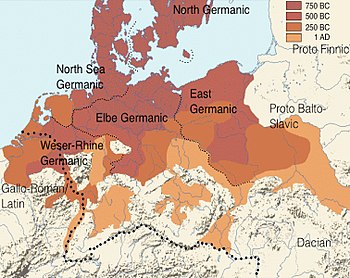Ancient Germanic culture
Distribution of the primary Germanic groups ca. 1 AD.

In its broadest sense, the term Ancient Germanic culture can be used to refer to any culture as practised by speakers of either the Common Germanic ******** or one of its daughter dialects (Gothic, Vandalic, Burgundian, Lombardic, Old High German, Old Frankish, Old Saxon, Old Frisian, Old English, and Old Norse) at any time during the roughly two millennia between the emergence of Proto-Germanic in the Nordic Bronze Age (ca. 1000–500 BC) until the Early Middle Ages (ca. 500–1000 AD). Although 'Germanic' can only be used with any sort of definition in a linguistic sense, the degree of cohesion and relative conformity which existed in Ancient times between the various groups of Germanic speaking peoples in terms of mythology, religion, customs, social structure and material culture is seen to justify the use of the term to refer to the culture of those peoples as a whole. The ancient Germanic people made a considerable impact on the development of ancient Europe, particularly through their interactions with the Roman Empire. They have been variously portrayed in the annals of history; sometimes as 'barbarian hordes', ultimately responsible for the Fall of Rome; at other times, as 'noble savages' living in blissful ignorance of the evils of civilization; at still other times, as Rome’s most enthusiastic supporters and eventual successors. Regardless of how one judges them, it is certain that the ancient Germanic peoples changed the face of Europe – and through their descendants, the world – dramatically.
Source:wikipedia
Ancient Germanic culture
No comments:
Post a Comment